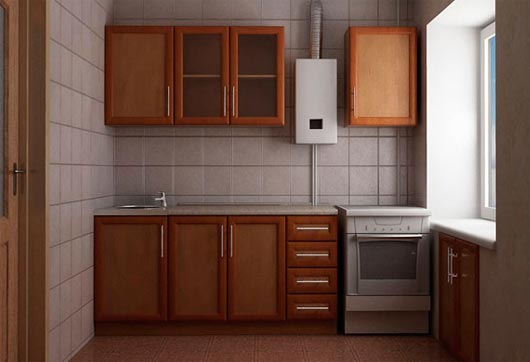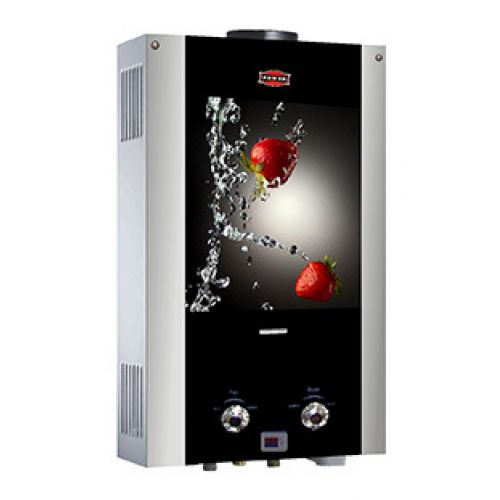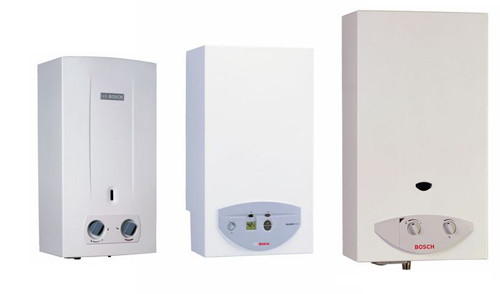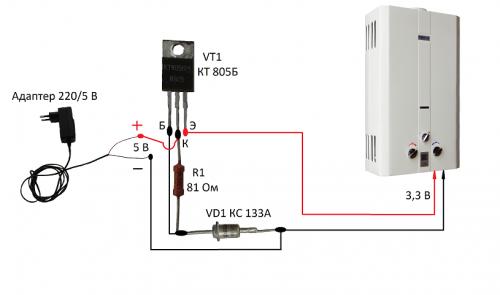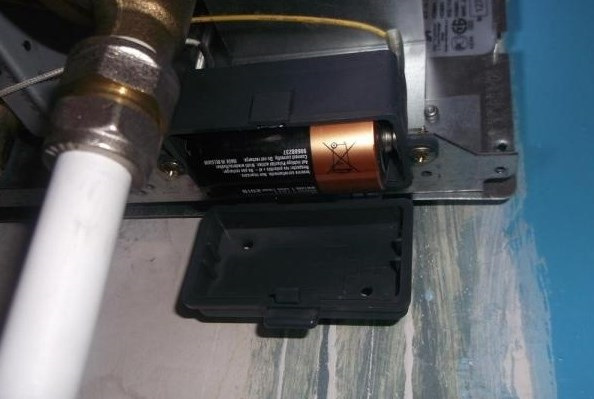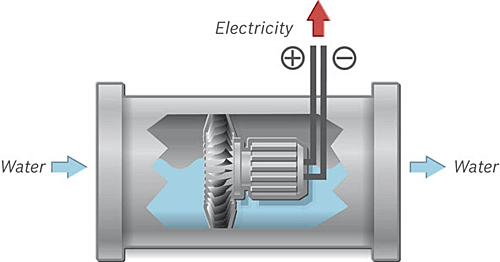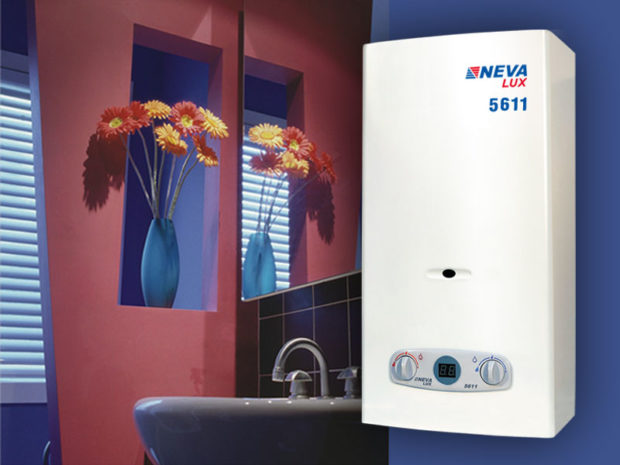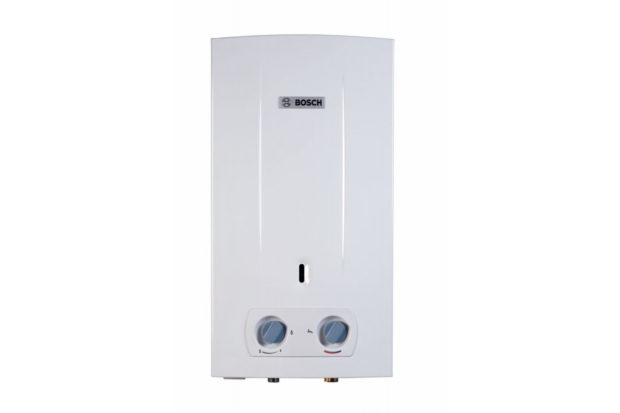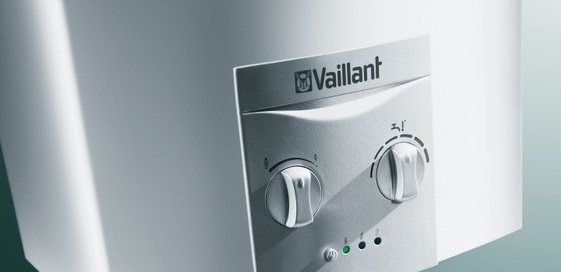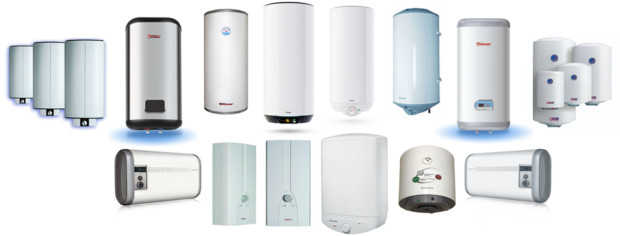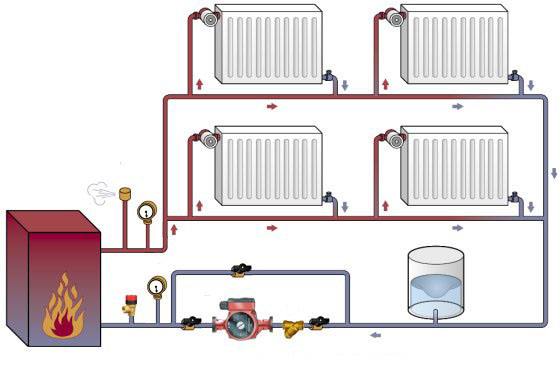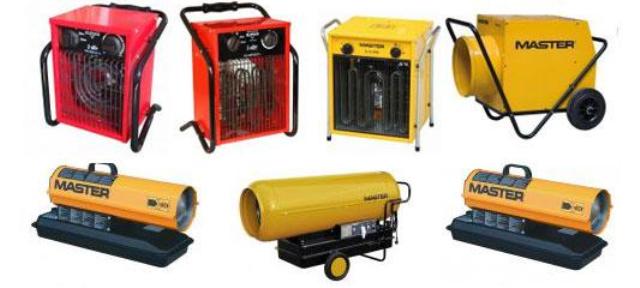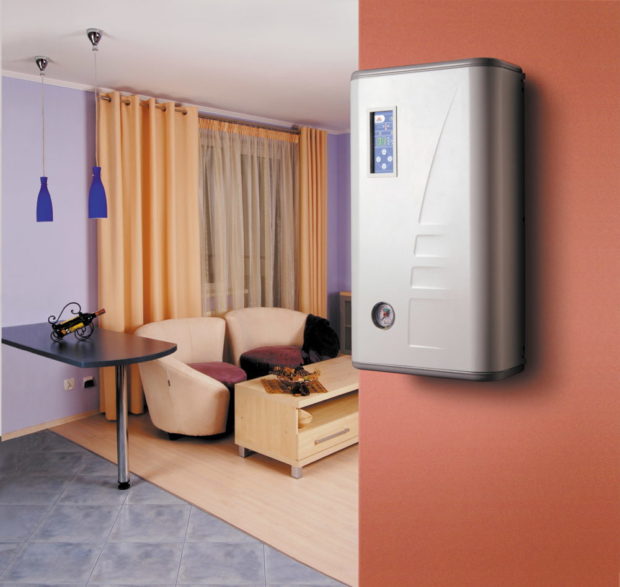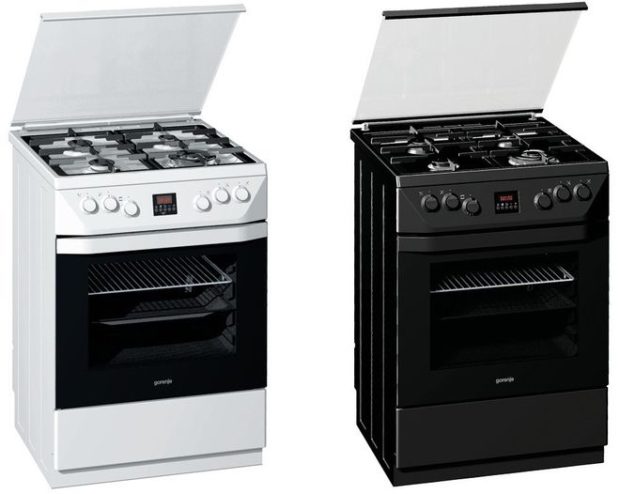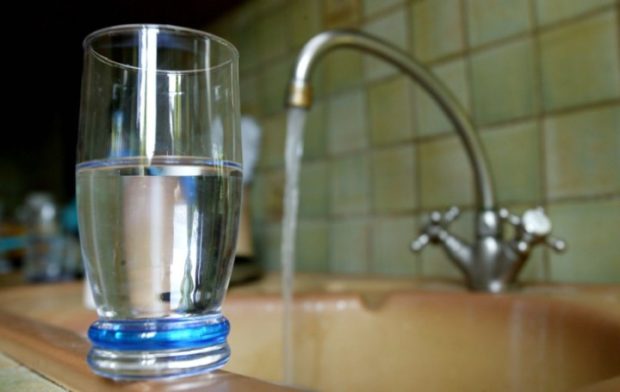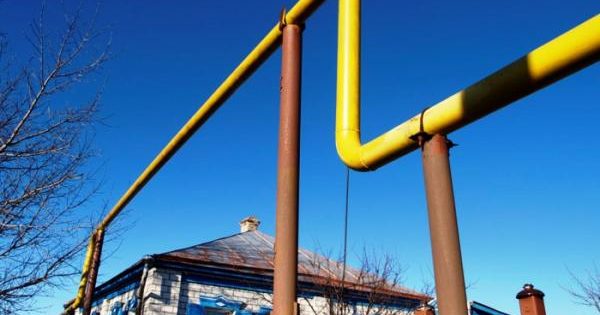10 tips on how to choose a geyser (gas water heater) for an apartment
The first geysers appeared in Germany in 1895, and in Russia they began to be actively used only in the middle of the last century. Then the country was experiencing a boom in housing construction, and hot water and a private bath became mandatory attributes of a city apartment, only connected to the common system hot water not everyone succeeded at home. Then in Khrushchev and early Brezhnev and began to put columns - flow-type gas water heaters. The choice was small, and in terms of ease of use, the first units left much to be desired. Today, such devices have become more technologically advanced, functional and safe, and their range has grown significantly. Let's try to figure out how to choose a gas water heater for an apartment and a house, and we will figure out which parameters are worth paying attention to.
No. 1. Types of gas water heaters: instantaneous and storage
Depending on the device, gas water heaters are divided into two types:
- flowing;
- cumulative.
Wall-mounted flowing water heaters are popularly called gas water heaters. They received the greatest distribution. Cumulative devices are practically not used in domestic spaces.
Instantaneous gas water heaters
The geyser does not have a storage tank and is designed to instant heating of water. Inside the unit is a heat exchanger through which a water tube passes. Under the heat exchanger is a gas burner. The combustion of gas generates heat, which heats the water passing through the heat exchanger. Exhaust gases are collected in a manifold and taken to the street. This is a schematic diagram of the column, but the features of the functioning of some nodes from model to model may differ.
In the simplest columns light the burner will have to be manually, in more expensive models automatic ignition is provided: as soon as someone turns on the faucet with hot water, the column starts to work, and turns off when the faucet is closed. Water temperature can be controlled by a simple reducer or sophisticated modern electronics.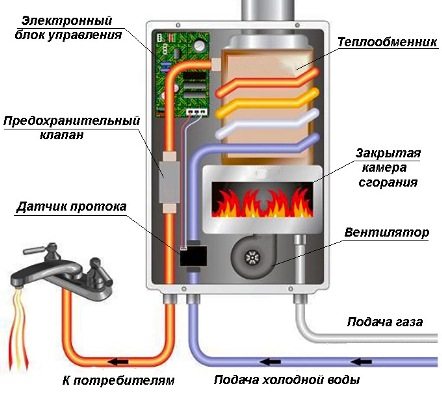
From a school chemistry course, you must remember that oxygen is needed in the air to burn gas. Simple household speakers are equipped with an open combustion chamber and get air from the room. Combustion products are removed either through normal chimney (option for private houses), or through a horizontal pipe with a fan providing forced draft. The latter option is used in apartment buildings.
Geysers are equipped multistage security systemTherefore, they cannot cause any harm, unless, of course, the installation was carried out correctly, and you do not violate safety precautions.
Advantages of geysers:
- compactness. Even the most powerful unit, which is able to heat water for several points of water intake, does not take up much space, and can be very carefully disguised in the kitchen;
- profitability. To heat water using gas is much cheaper than using electricity. Moreover, in some cases, the preparation of hot water in this way is even cheaper than its centralized supply;
- the ability to work with multiple points of water intake. To provide water heating for 3-4 or more points of water consumption with flowing electric heater, you will have to take a device with a capacity of more than 8 kW, which means that a network with a voltage of 220 V will not be enough - it will be necessary wiring with a three-phase voltage of 380 V. A gas water heater designed to work with the same number of water intake points can be connected to ordinary city gas lines - their power will be enough.

Some manage to put a column even in rooms that are not connected to the gas pipeline, as there are models that allow powered by gas bottle.
There are geysers and cons:
- more complicated installationwhen compared to electric heaters. You can’t do it on your own - you need to attract specialists and get special permission;
- the gas line must have sufficient power. As a rule, this is not a problem - in most apartments there will be enough power. Where only a gas stove is installed, the network capacity may be insufficient;
- combustion products must be removed somewheretherefore need chimney construction. The easiest way will be to residents of private houses and upper floors. The rest will have to erect a chimney on the outer wall of the house or install a turbine column and punch a hole in the wall;
- hazard caused by improper operation. To minimize risks, purchase a speaker with protective automation. By the way, all modern devices and most, released decades ago, are equipped with the necessary security systems. In addition, it is important to ensure the flow of the required amount of fresh air: 10 units of the volume of supply air should flow per unit volume of gas burned.

Accumulative gas water heaters
Similar devices in design resemble electric boilers. The difference lies only in the source of heat: instead of electricity, gas is used here. The basis of such a unit is a storage tank, where a stock of hot water is stored. A tube passes in the tank - this is a heat exchanger, inside which hot products of gas combustion move. A burner is installed in the lower part of the tube, where the combustion process takes place. So that the gases, moving up, have time to give all their heat, the heat exchanger receives a complex design with dividers.
The volume of the tank ranges from 50-500 liters, but the most widespread models of 100 and 200 liters. For a family of 2-3 people, an aggregate of 80-150 liters is suitable. The tank receives reliable thermal insulation, so once a heated supply of water can be stored for a relatively long time - there is no need to turn on the device each time.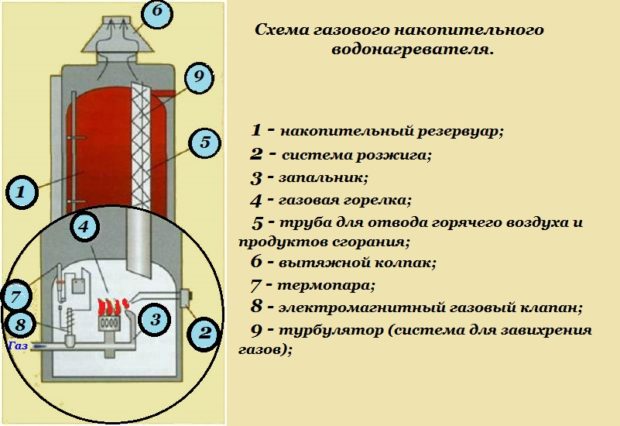
To the main advantages storage gas water heaters include:
- profitability;
- the presence of a constant supply of hot water;
- the ability to install where the gas supply line is weak;
- the ability to work with a large number of water intake points.
Similar aggregates take up a lot of space, but this is not their main drawback. They are standing quite expensive, in our area have not gained distribution, therefore their assortment is extremely modest. Most opt for flow heaters or double-circuit boilers. Due to the low popularity of this kind of aggregates, we will focus on how to choose a gas column - a device with flow-through type of heating.
No. 2. Power of geysers
Power of a geyser is indicated in kW. It is directly related to performance equipment and indicates how many liters of water per minute can be heated column. It is worth noting that the best geyser is not necessarily the most powerful device. It all depends on how many people live in the apartment, and how many of them can use hot water at the same time (or how many hot water faucets installed). It is believed that one mixer is capable of passing 6-7 l / min. It is enough to multiply this parameter by the number of cranes, throw a small margin and get the result. Power is indicated either on the column itself or in the technical documentation for it. For example, a column with a power of 23-24 kW allows you to heat about 14 liters of water per minute to a temperature of about 25 degrees.
By power, the columns are divided into several types:
- 17-20 kW - the minimum power sufficient to supply one point of water intake, i.e. can either be comfortably accepted showeror to wash the dishes - and then, and then at the same time it will be difficult to do. Their productivity is 9-10 l / min, not more. Option for a small family or one person;
- 20-26 kW - medium power columns, heat 15-20 l / min and are suitable for heating water to a comfortable temperature for 2-3 points of water consumption. The most popular option;
- more than 26 kW - powerful units for large families and private homes.
In pursuit of power, do not lose common sense and do not forget to take into account the water pressure indicator. It makes no sense to take a column designed to heat 25 liters of water per minute, if the water supply network is not able to provide such a pressure.
No. 3. Type of gas column ignition
The ignition type is one of the most important column parameters. It depends on how often you will approach the device, as well as how safe and economical the process of receiving the flame will be. So, in gas columns one of the following can be used types of ignition:
- manual ignition typewhen it is necessary to bring a match to the burner in the columns currently produced practically not used - this method went into legend, as it was not very safe and extremely inconvenient, especially if the unit was in a remote place. It does not make sense to dwell on manual ignition in detail;
- piezo ignition - An improved version of the manual method. Here the spark is taken not from a match, but when a special button is pressed. With its help it is ignited pilot burner (as is the case with manual ignition). It is always on while in standby mode. When someone turns on hot water, the main burner lights up, and after turning off the hot water, it goes out. Due to the fact that the pilot burner always maintains the flame, It’s impossible to call such columns economical. But there are devices with such ignition inexpensively and are completely non-volatile - for areas with frequent power outages This is the best option. In fairness, it is worth noting that the financial losses from the constant burning of the pilot burner are not particularly significant, especially in modern columns;

- electric ignition. The supply of gas and the beginning of its burning occurs only when someone in the apartment turned a hot water valve. Up to this point, gas is not consumed. When the valve closes, access to the gas is blocked by a special valve, and combustion does not occur. That is why such columns are considered the most economical and modern, and the lack of the need to light a flame (even if this is done without a match, but only with a button) is a big plus in terms of operating comfort. Minus - higher price such columns and dependence on the availability of electricity, but managed to get rid of the last minus in some models.

Columns with electric ignition can be divided into two types: volatile and non-volatile. In a volatile ignition system, it is connected to a household electrical outlet.If you live in a city apartment and do not experience any special problems with the supply of electricity, then this is quite a good option. In non-volatile electric columns ignition can be implemented in several ways:
- use of batteries. It is advisable to use powerful alkaline batteries and change them regularly, since lowering the supply voltage can cause characteristic pops when the burner starts. As a rule, the charge level is displayed. In some columns, batteries are used as a backup ignition system;

- hydrodynamic ignition. The energy sufficient for ignition is obtained by the operation of a small hydrogenerator. As soon as you turn on the faucet with hot water, the turbine starts to rotate and energy is generated for ignition, which takes a matter of seconds. It’s convenient and practical, it’s just that the columns with the hydrogenerator are expensive, but if something happens, the repair will be difficult.

Number 4. Type of combustion chamber
To choose a gas column, you need to pay attention to a lot of technical details, and the type of combustion chamber is one of the most important points. There are only two options:
- open combustion chamber;
- closed combustion chamber.
Open camera speakers - the simplest and cheapest. They use air from the room in which the device hangs to burn gas. The fence is through the holes at the bottom of the column. Such units are mounted in kitchens or in separate utility rooms (an excellent option for owners of private houses). Combustion products are discharged through the chimney due to natural draft. Such devices are distinguished by minimal noise during operation, but are more suitable for private houses, since they require connection to a chimney. In addition, in the room where the device will be installed, it is necessary to ensure sufficient ventilation.
Closed-chamber speakers get air from the street. The chimney in such units is horizontal, comes out through the wall and is represented by a coaxial pipe (pipe in the pipe). On the inner part of the pipe, the combustion products are vented to the street with a fan, and air is supplied to the column through the external pipe. You can install such a unit in any room, it is safer, but you will have to pay more for such a column, and the operation of the fan depends on the availability of electricity and is accompanied by a small noise.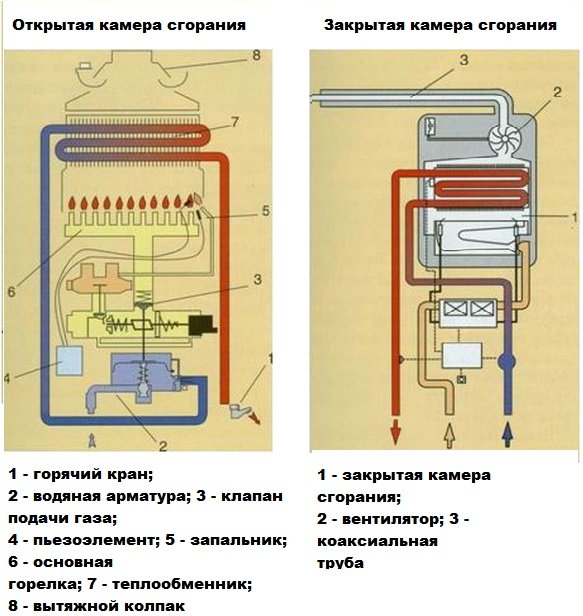
No. 5. Combustion products
In part, we have already considered this issue above, but now we will dwell a little in more detail. According to the type of carbon monoxide removal, the columns are:
- classic, with chimney. Great for homes that already have a chimney. Otherwise, it will have to be built separately. For residents of apartment buildings, such an option is in most cases impossible to implement;
- chimneyless or turbine. Combustion products are discharged through a pipe for which a hole is made in the wall. The combustion products are pulled due to the operation of the fan.
The room in which the column stands must be well ventilated. If installed plastic windows, you will have to equip them with a ventilation valve.
No. 6. Type of column heat exchanger
The durability and wear resistance of the column are directly related to the material of manufacture of the heat exchanger:
- steel heat exchanger inexpensive, weighs decently, relatively reliable in operation. It is better to choose a model where the heat exchanger is made of stainless steel;

- highly refined copper resembles steel in basic properties, but has a higher heat transfer, so it will be possible to extract the maximum benefit from each cubic meter of gas;
- plain copper warms up unevenly, all the fault - impurities. That is why many manufacturers cover the heat exchanger. heat resistant paint, but it is only able for a while to restrain the destructive processes in the heat exchanger.
It turns out that the preferred options are stainless steel and purified copper.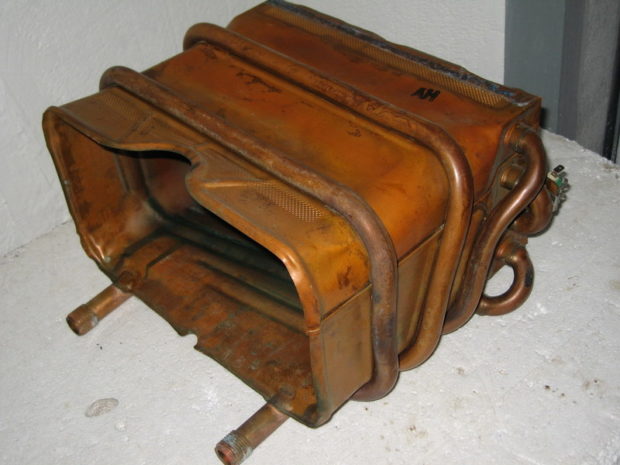
Number 7.Water and gas pressure
For each column, two main parameters of water pressure are registered in the data sheet: the minimum at which the unit will turn on, and the maximum is the pressure that the heat exchanger can withstand without losing integrity. Before choosing a geyser, it is advisable to clarify all the parameters of your water supply network. For city apartments where speakers are operated (and this is for the most part Khrushchev and stalin, i.e. old housing stock with worn communications) it is better to choose a unit that can work with a minimum pressure of water. Therefore, pay attention to those devices that can heat water with a pressure already at 0.15 bar.
High pressure can be devastating for the column, and water hammer, alas, is not uncommon. Purchase units that can withstand a short-term increase in network pressure to 11-12 bar.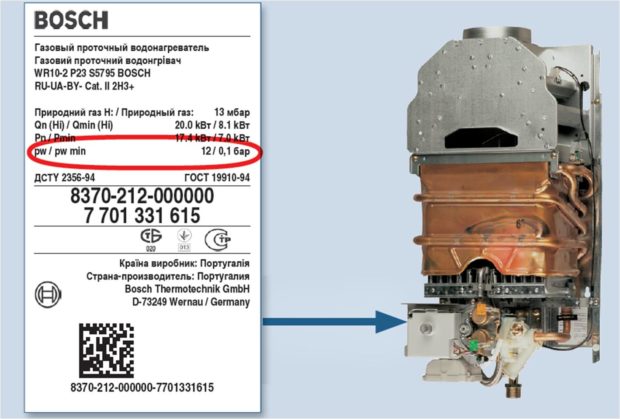
Also do not forget to specify with which gas pressure column may work. In domestic gas pipelines, gas pressure is lower than in European ones (13 mbar versus 20 mbar), so when buying a European-made column, you need to ask what market it was produced for and if a gas reducer is installed in it in order to maintain constant pressure.
Number 8. Burner Type and Power Modulation
Burners in gas columns can be of two types:
- with constant power. The easiest option, the main advantage of which is low cost. When changing the water pressure, you will have to manually change the temperature on the column, and you can be tormented like that. If you do not change the temperature, then water can flow at a burning temperature. Let's say your neighbor turned on the water or someone let the water in toilet bowl. The water pressure has decreased, and the flame strength has remained the same, therefore the reduced amount of water that will flow through the heat exchanger will heat up to uncomfortably high temperatures;
- modulated power. Everything is much more modern here. You just need to enter the desired water temperature, and the flame power will be regulated depending on the pressure of the water. This is the preferred option. Of course, the regulation of water temperature is present on all columns, but conventional devices cannot adapt to changes in pressure and gas pressure, and units with modulated power will produce water with clearly necessary parameters under almost any conditions. Such speakers cost more, but in operation are not only more comfortable, but also more economical.
Of course, a modulated power burner will be the preferred option.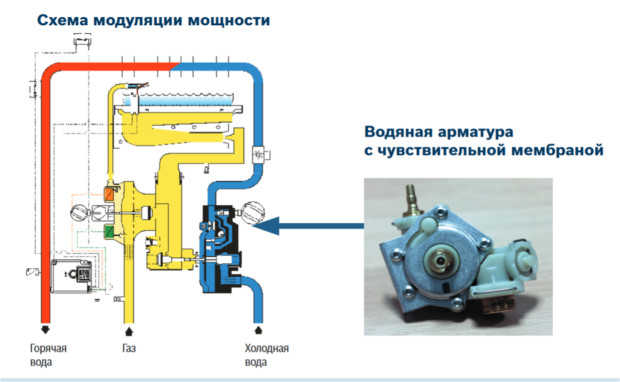
No. 9. Geyser Security System
Many are still afraid to use geysers. Data on the sale of real estate indicate that apartments with similar equipment are 15% cheaper than similar ones, but without gas water heaters, and 70% of buyers do not even consider buying such a home. If you approach wisely the choice and operation of a gas column, then all the risks can be minimized. It is important that the column automatically shuts off when there is no supply of water, gas or the necessary traction, and does not allow carbon monoxide poisoning. For this, modern units are literally stuffed with all kinds of security systems:
- the ionization sensor turns off the device when the gas supply stops;
- the combustion sensor also turns off the column if the flame goes out. Ionization and combustion sensors can be used in pairs;
- the draft detector will not allow you to turn on the column or turn it off in the absence of draft in the chimney, saving the house from filling with carbon monoxide;
- a flow detector ensures the normal functioning of the column and its inclusion when someone turned the faucet with hot water;
- the overheating sensor disables the column if the water temperature has reached a threshold value. Protects the heat exchanger from rupture, and the person from burns;
- the low-pressure water detector will not allow the column to turn on if the pressure in the water supply is insufficient, thereby saving the heat exchanger from burning;
- an emergency pressure relief valve protects the column from increased water pressure;
- a temperature sensor for cold and hot water is necessary for the correct setting of the temperature of the water leaving the tap.

No. 10. The best manufacturers of gas water heaters
It is hard to argue with the well-known fact that famous companies produce high-quality, reliable and durable equipment. When safety and comfort are at stake, it’s better to overpay a little, but sleep peacefully, so we recommend pay attention to geysers of such manufacturers:
- Bosch, Germany - high-quality reliable equipment with the ability to maintain water temperature with variable pressure. There are models of various capacities;

- Beretta, Italy - a wide range of gas water heaters. Each model is presented in a whole range of capacities. The manufacturer pays attention to design, so for those who do not mess up the main thing interior, these units are recommended for use;
- Zanussi, Italy - reliable and inexpensive equipment; most of the models are made in a classic style. Main advantages: economical gas consumption, low noise, copper heat exchanger, work with networks with low water pressure;
- Ariston, Italy - functional columns at affordable prices. All nodes that are subjected to increased loads are made of composite materials that are most resistant to corrosion;
- MORA-TOP, Czech Republic - a manufacturer with extensive experience, produces very high-quality columns with reliable and durable heat exchangers. All stages of assembly are carried out in Europe, all parts are of European production, so these columns can be trusted. In addition, in each model, both the most budgetary and the most expensive, a multi-stage security system is used;
- Vaillant, Germany - produces productive unpretentious speakers that are great for operation in our area;

- Electrolux, Sweden - columns with copper heat exchangers, excellent functionality and affordable price;
- Ladogaz, Russia - domestic production speakers that are manufactured according to European technologies and are inexpensive. Models are quite economical and maximally adapted to our operating conditions;
- NEVA, Russia - a St. Petersburg company, since the 90s it has been producing gas water heaters, working to improve their design and constantly expand the range. Columns are able to work with minimal pressure of water and gas, so in some cases they will be indispensable.
Finally, we note that there is no need to be afraid of geysers - you just need to learn to choose them correctly and monitor compliance with operating rules.

